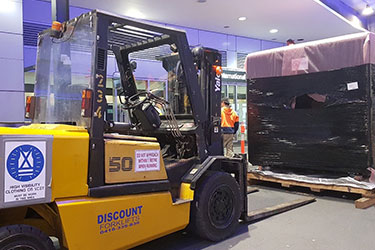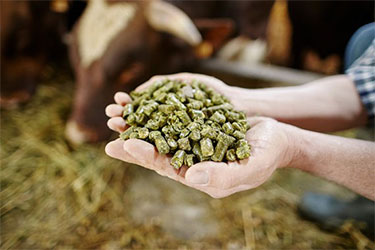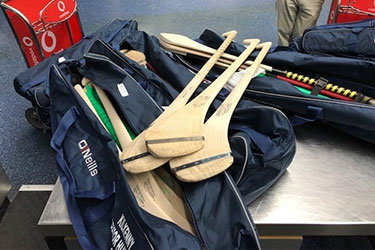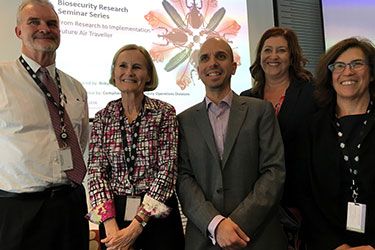Biosecurity is the management of the risk of pests and diseases entering, emerging, establishing or spreading in Australia and causing harm to animals, plants or human health, the economy, the environment and the community.
X-ray tech trial takes off at Melbourne airport

Delivery of the Rapiscan RTT®110 3D X-ray unit at Melbourne International Airport.
In a world-first, the department is trialling advanced 3D X-ray technology to better detect biosecurity risk material and accelerate the clearance of passengers at the border.
Under this 12-month trial, which recently started at Melbourne International Airport, biosecurity officers will use the Rapiscan RTT®110 3D X-ray unit, which is capable of scanning more than 1800 bags an hour, producing high resolution 3D X-ray images.
The X-ray unit will provide biosecurity officers with detailed 3D images of passengers’ baggage and allow them to see food, plant material or animal products more clearly.
Our officers will also program the Rapiscan to identify and detect biosecurity risks contained or concealed within baggage, and test whether it is possible to build an algorithm to automatically detect biosecurity risks.
Continue reading about x-ray tech trial takes off at Melbourne airport
Peta Lane, head of Biosecurity Compliance, said more than 30 million pieces of luggage pass through our international airports each day.
‘We’re always looking for ways to use new technology to improve our biosecurity system as international travel and trade increase,’ Ms Lane said.
‘This technology has historically been used for the screening of explosives and trialling it for biosecurity purposes in this way is a world first.
‘We are working in partnership with the Department of Home Affairs and the New Zealand Ministry for Primary Industries who are also testing an identical unit at Auckland Airport.’
With 24 million inbound passengers per year expected by 2020, it is important we find innovative ways to manage the increasing risk to Australia's biosecurity in an efficient way now.
If successful, there is potential to use the technology offshore to identify risks before they arrive in Australia and to share infrastructure at international airports, mail centres and air cargo depots with partner border agencies.
The trial has been funded under the $7.5 million allocated by the Australian Government for next generation technologies in the May 2018 federal budget.
Find out more about pest and disease surveillance at Australia’s borders.
Hitchhiking gets harder for the Brown Marmorated Stink Bug

Import measures protect our agricultural industries from a serious biosecurity threat, the brown marmorated stink bug.
The department has implemented import measures, supported by system enhancements, to better protect our agricultural industries from the brown marmorated stink bug (BMSB), a serious biosecurity threat.
Dr Kim Ritman, Australian Chief Plant Protection Officer, explained that the BMSB poses a high biosecurity risk to Australia, and that overseas it is having a significant impact on agriculture and as a nuisance pest.
‘Preventing an incursion in the first place is a high priority for the Australian Government and industry. A BMSB incursion would be extremely difficult and expensive to manage,’ Dr Kim Ritman said.
‘These pests can ‘hitchhike’ on break-bulk cargo and containers, particularly those shipped to Australia in the high risk season between 1 September and 30 April.’
Continue reading about hitchhiking gets harder for the Brown Marmorated Stink Bug
This BMSB high risk season coincides with autumn and winter in the Northern Hemisphere, when these pests like to hide in dry spaces including cargo destined for shipping to Australia.
The number of target risk countries has been expanded and there will be stricter biosecurity conditions governing goods shipped from these countries during the BMSB season.
The measures are supported by external and internal system enhancements that will help streamline the importation of sea containers and cargo this BMSB season.
There is now a category specifically for BMSB in AEPCOMM, allowing accredited customs brokers and self-reporting importers to assess documentation and direct consignments, which may be subject to BMSB, for examination and treatment if needed. The new procedures were recently demonstrated in the AEPCOMM BMSB webinar.
Enhancements have also been made to our internal S-Cargo system to better manage the risk of BMSB associated with smaller shipments of goods (LCL), and freight that’s been pooled together (FAK).
These changes improve our ability to prevent the movement of containers from the wharf before appropriate biosecurity risk assessments can be carried out, and reduce the manual practices involved in this process.
Future S-Cargo enhancements will help us target containers for intervention based on country, port or entity compliance history, further strengthening our BMSB risk profiling and targeting capabilities.
Find out how to identify and report BMSB and other invasive, hitchhiking pests.
Managing the risks of imported stockfeed

Stockfeed.
As the drought continues to affect farmers in eastern parts of the country, interest in sourcing stockfeed from overseas has been growing.
Imported stockfeed is a high biosecurity risk because it can provide a direct pathway for the introduction and spread of exotic pests and diseases harmful to people, animals, crops and the environment.
Australia uses a long established policy framework to manage biosecurity risks to keep our agriculture and tourism industries and the environment protected.
The department’s Plant Import Operations branch Assistant Secretary, Lois Ransom, said that every stockfeed import application is assessed against the requirements of this framework, and the import will only be permitted if the assessor is confident that the biosecurity risks can be managed.
Continue reading about managing the risks of imported stockfeed
‘If you’re applying to import processed plant-based stockfeed or whole grain, we will undertake detailed assessments and ensure appropriate monitoring and control processes are in place to manage both animal and plant biosecurity risks,’ Lois Ransom said.
‘Hay for stockfeed use has never been imported into Australia due to the high risk of introducing plant and animal pathogens, viable crop seed, insect pests and weeds.
‘Any import conditions we set to reduce these risks would be very strict, making them complex and prohibitively expensive.’
Australia applies strict conditions to imports of plant-based stockfeed, supplements and whole grain.
Domestic alternatives are available, and domestically produced stockfeed has a lower risk of introducing an exotic pest or disease, but movement may be subject to interstate regulations. Check with your state or territory DPI for advice on sourcing local stock feed alternatives and any quarantine entry conditions.
Find out more about the application process and how we manage the risks with importing plant-based stockfeed and supplements.
Updated telecommunications in the Torres Strait

Biosecurity surveillance in the Torres Strait.
Mobile towers have recently been upgraded across the central and eastern islands in the Torres Strait, meaning our biosecurity officers can use new technologies to monitor biosecurity risks in the north.
The Digital Foundation Project was completed by the Torres Strait Regional Authority and Telstra, and the department committed $2m through the Agricultural Competitiveness White Paper, the Australian Government’s investment in improving biosecurity and analysis.
As a result, internet data speeds are significantly improved, ‘down days’ are fewer, and officers can now transmit larger files like those associated with surveillance imagery.
This means teams on the ground can more effectively manage biosecurity risks, protecting Australia’s unique environment, agricultural production and our quality of life.
Continue reading about updated telecommunications in the Torres Strait
The Torres Strait is a well-recognised incursion pathway, and this project has improved communications between some of our officers that need it the most to do their jobs well.
Improving voice and data access continues to improve the collection and transfer of biosecurity risk information, which improves our analytical capability. This means the department can better target resources to the areas of highest risk.
Increased connectivity provided through this project has also led to better outcomes in the provision of services to these communities such as health, education and economic development.
Find out more about biosecurity in the Torres Strait.
Supporting the luck of the Irish

11 of the Irish hurley sticks that came through Sydney Airport. Not pictured – 139 more…
Supporting, promoting and upholding the integrity of Australia’s biosecurity requires a collaborative effort from our officers located all around Australia, and around the world.
Recently, Australia’s Embassy in Dublin was contacted by the Gaelic Athletics Association for advice on how to bring 150 hurleys into Australia.
A hurley is a wooden stick made from ash wood used in the Irish sport of hurling. These sticks were used in a historic hurling match between the Galway Tribesmen and Kilkenny Cats as part of the 2018 Sydney Irish Festival, with teams competing for the coveted Wild Geese Trophy.
To ensure that there were no unnecessary obstacles or delays for the teams’ arrival into the country, Department of Agriculture and Water Resources officials worked with the Department of Foreign Affairs and Trade across four cities —Dublin, Brussels, Canberra and Sydney— to facilitate the arrival of these wooden sticks into Australia.
Continue reading about supporting the luck of the Irish
Undeclared items made from wooden material can bring in unwanted pests and diseases onto Australian soil. Wooden articles can carry timber borers, insect pests, bark and other contaminants.
If wood borers were to weave their way into the country, they could significantly impact a wide variety of host plants and threaten our $60 billion agricultural industry.
This is why it is important for travellers to declare any of these items on their incoming passenger card. Don’t be sorry, just declare it.
Find out more about travelling to Australia.
Botanic gardens join the fight against plant pests and diseases

Banksia coccina Image courtesy of Australian National Botanic Gardens
Australia will soon have a powerful new weapon in the fight against plant pests and diseases, with work underway to establish a sentinel surveillance program in the nation’s botanic gardens and arboreta.
The department is providing funding to Plant Health Australia through the Agricultural Competitiveness White Paper to embark on this valuable project.
Dr Marion Healy, First Assistant Secretary of the department’s Biosecurity Plant Division, said the nation’s 150 botanic gardens and arboreta could provide an important early detection of threats to our agricultural industries and environment.
‘The living plant collections held by our nation’s botanic gardens and arboreta are a unique resource that can provide vital information about the state of the nation’s plant health,’ Dr Healy said.
Continue reading about Botanic gardens join the fight against plant pests and diseases
‘Our gardens and arboreta hold a range of native flora, exotic species and relatives of crop species, making them ideal sentinels for any new plant pest or disease incursions.
‘Gardens and arboreta are also vital to the enjoyment of life in Australia’s cities and towns, attracting millions of visitors every year, and providing an important place for community relaxation and recreation.’
Dr Healy said this new White Paper project would complement other work being undertaken by the department in partnership with Plant Health Australia, industry, researchers and the community.
‘Stronger surveillance in botanic gardens and arboreta will support the implementation of the National Forest Biosecurity Surveillance Strategy, and potentially provide a powerful new avenue for public education on plant biosecurity.
‘Better integrating botanic gardens and arboreta into our national plant health surveillance system will deliver benefits for all Australians.’
This project is part of the Australian Government’s investment in improving biosecurity and analysis through the Agricultural Competitiveness White paper.
Find out more about Australia’s favourable plant health status.
‘Future Air Travellers’ research

From left to right Dean Merrilees, Robyn Martin, Jose Arias, Rosemaree Lenertz and Stephanie Quispes Garay.
The department recently hosted the ‘Future Air Traveller’ from research to implementation seminar, to explore the way research and innovation can be used to protect Australia’s valuable agriculture, tourism industries and unique environment.
The seminar, hosted by the department’s Compliance Division and the Biosecurity Operations Division, touched on the increasing traveller volumes and emerging global pest and disease threats that highlight the need for effective and practical solutions to manage biosecurity risk at Australia’s airports.
Peta Lane, head of the department’s Compliance Division, said it is more important than ever we innovate our management of biosecurity risk.
‘Globalisation, the complexity of international supply chains, increasing traveller and trade volumes and emerging global pest and disease threats are making our management of biosecurity risks more challenging,’ Peta Lane said.
Continue reading about ‘Future Air Travellers’ research
‘Incorporating innovative technologies and approaches to help us work smarter, not just harder.
‘Innovating how we do business will provide opportunity to better target risk, push risk offshore, ease pressure on our borders and help us undertake our work more effectively and efficiently.’
The seminar follows on from the Australian Government’s $313 million funding commitment to invest in a stronger, world-class biosecurity system over the next five years and the inaugural Biosecurity Innovation Exchange 2018.
Staff from the department have been working with the Department of Home Affairs, state and territory governments, the New Zealand Ministry for Primary Industries and the University of Melbourne’s Centre of Excellence for Biosecurity Risk Analysis to improve Australia’s biosecurity system.
Analytics and new technologies are the key focus of the department’s future traveller reforms, and this work is great example of collaboration delivering science-based solutions to address modern challenges.
Find out more about biosecurity innovation.
Border finds: spicy rabbit heads

A very spicy rabbit head at the Sydney Gateway Facility.
Biosecurity officers at the Sydney Gateway Facility had the hares on the back of their necks stand up when they found this spicy package earlier this year.
An X-ray of goods entering the country found a package containing spicy rabbit heads, destined for human consumption. Biosecurity officers conducted a thorough inspection of the parcel and contents, and the items were destroyed.
If an item does not meet Australian import conditions it must be treated, exported or destroyed at the importer’s expense.
Certain food, plant material and animal items from overseas could introduce serious pests and diseases into Australia, devastating our valuable agriculture, tourism industries and unique environment.
When you send mail to Australia, make sure you accurately declare the contents of your package on the postal declaration label.
Find out more about bringing or mailing goods to Australia.
Border finds: Live cactus in a keychain found at the Sydney Gateway Facility

live cactus keychain.
Biosecurity officers at the Sydney Gateway Facility found themselves in a prickly situation when they found this live cactus keyring package earlier this year.
Survey detection of goods entering the country found a keychain containing a live cactus. Biosecurity officers conducted a thorough inspection of the parcel and contents, and the cactus was exported back to its point of origin.
If an item does not meet Australian import conditions it must be treated, exported or destroyed at the importer’s expense.
Certain food, plant material and animal items from overseas could introduce serious pests and diseases into Australia, devastating our valuable agriculture, tourism industries and unique environment.
Cacti may be infested with hitchhiker pests and diseases such as beetles, mealy bugs, mites, slugs, snails, aphids, thrips, or Phytophthora cactorum.
When you send mail to Australia, make sure you accurately declare the contents of your package on the postal declaration label.
Find out more about bringing or mailing goods to Australia.
We want your input

The department is currently seeking feedback on:
- a risk analysis for fresh longan fruit from Vietnam
- food safety certification requirements for imported bivalve molluscs
See the latest Import industry advice notices or Export industry and market access notices.
